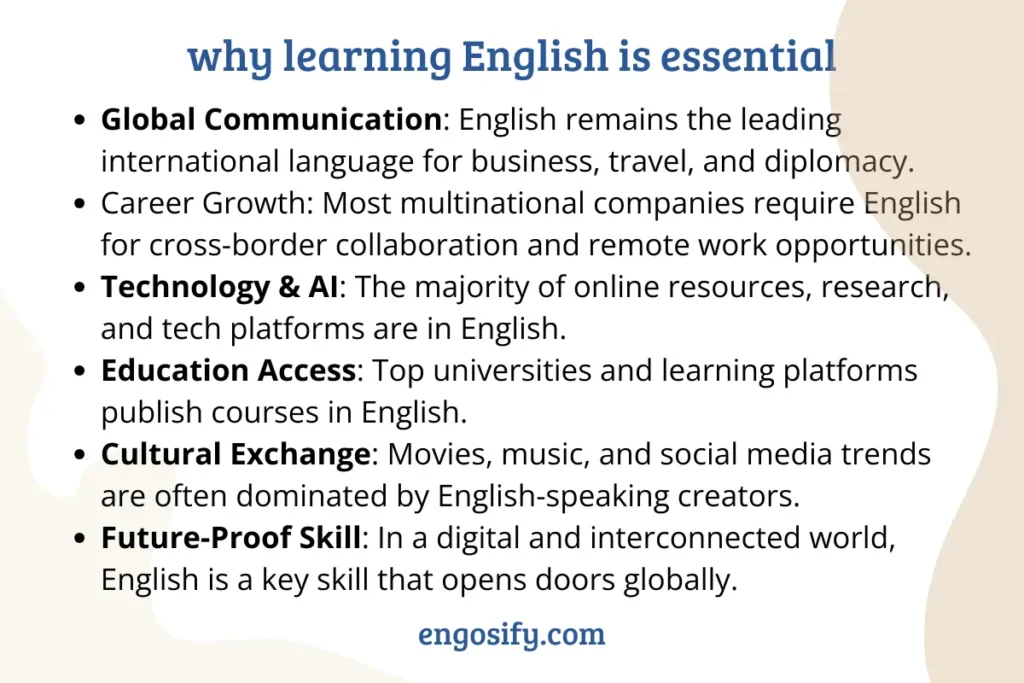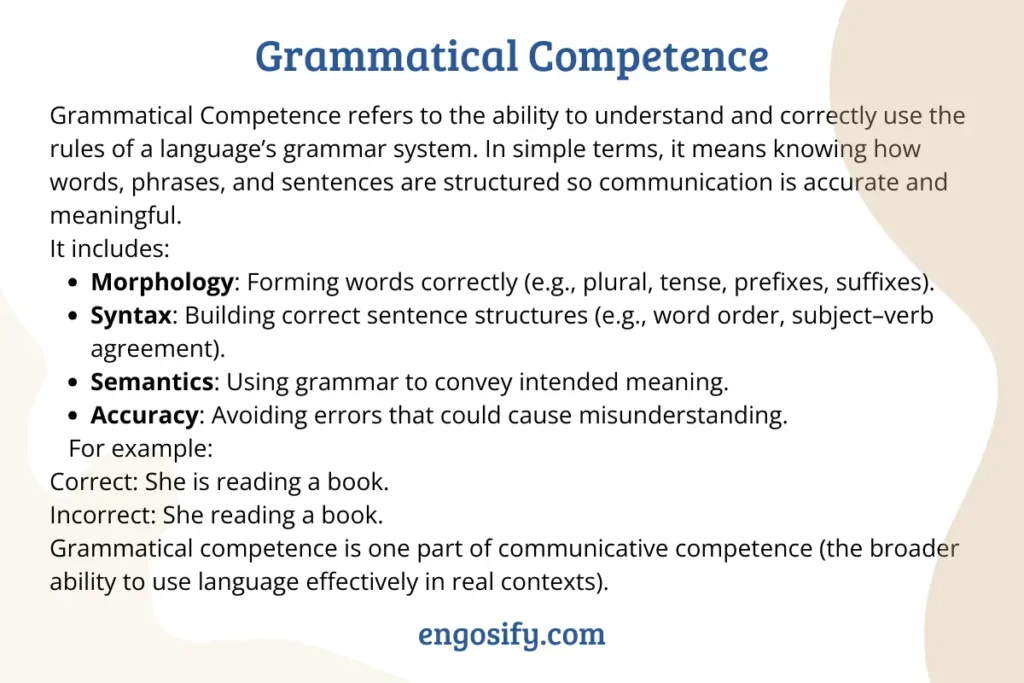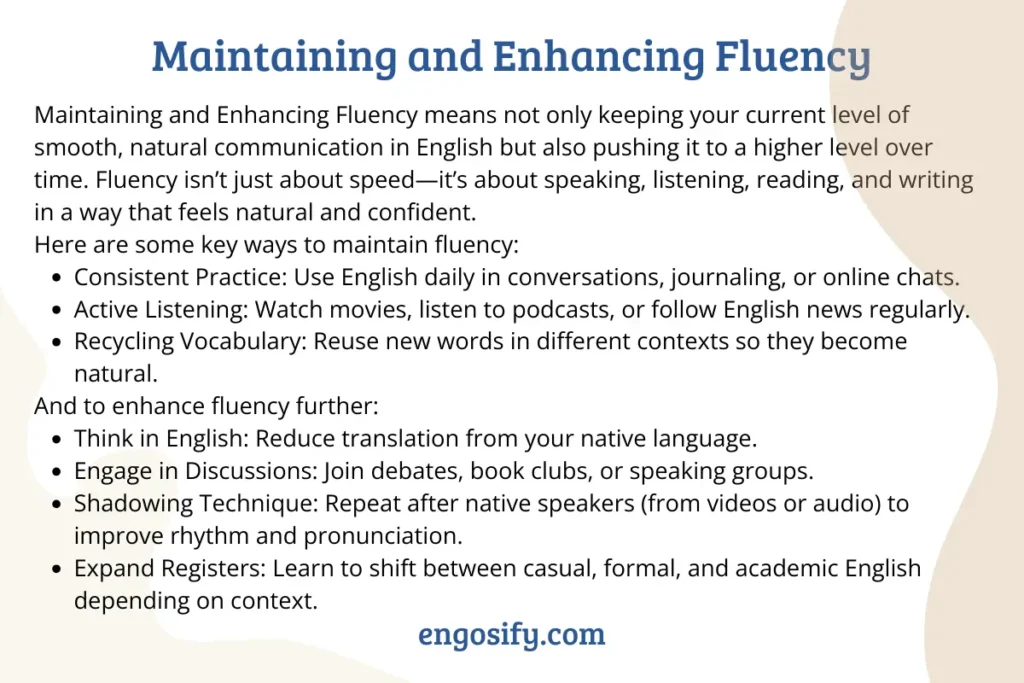Learning English can feel like climbing a mountain sometimes—overwhelming at first, but totally achievable with the right plan. Whether you’re starting from scratch or brushing up on rusty skills, this roadmap is designed to take you from a hesitant beginner to a confident speaker, reader, and writer of English. Along the way, we’ll explore techniques that make learning practical, fun, and engaging, from building your vocabulary to mastering grammar and boosting speaking skills. By following this step-by-step guide, you’ll gain clarity on what to focus on at each stage, avoid common pitfalls, and steadily move toward fluency.
Introduction to English Learning Roadmap
Why Learning English is Essential in 2025
In today’s fast-paced world, English isn’t just a language—it’s a bridge. For work, travel, and connecting with people globally, knowing English opens doors that might otherwise stay closed. But here’s the thing: it’s not just about memorizing words or cramming grammar rules. The secret is combining real-life practice with smart learning strategies. And, believe it or not, starting small—like listening to short English podcasts daily—can make a huge difference over time.
The good news? You don’t need to be perfect. Making mistakes is part of the journey, and the sooner you embrace them, the faster you’ll improve. Plus, there’s a ton of free resources online, like BBC Learning English, which can give you daily listening practice without breaking a sweat.
Setting Realistic Expectations
Here’s where many beginners stumble: impatience. Learning English takes time, but setting realistic goals can keep you motivated instead of frustrated. For instance, instead of aiming to be fluent in three months, start with smaller milestones:
- Learn and use 10 new words a day
- Practice speaking for 10 minutes daily
- Write a short journal entry in English
Remember, consistency beats intensity. Even if you study a little each day, the results accumulate. Think of it as planting seeds—you water them daily, and soon, you’ll see the growth.
And while books and apps are helpful, nothing beats immersion. Surround yourself with English: label items around your house, watch English shows with subtitles, and chat with native speakers when possible. It might feel awkward at first, but that’s how fluency slowly creeps in.

Laying the Foundation
Learning English is a lot like building a house—you need a strong foundation before you decorate or move in. Without solid pronunciation, listening skills, and vocabulary, it’s easy to get frustrated. In this part, we’ll cover practical ways to lay that foundation so you can grow your confidence step by step.
Step 1 – Mastering Pronunciation and Listening
Understanding English Sounds
Let’s face it: English pronunciation can be tricky. Words don’t always sound the way they’re spelled, and some letters are silent or double up. That’s why learning the International Phonetic Alphabet (IPA)—even just a little—can save you tons of headaches. It’s like having a cheat sheet for correct pronunciation.
Start small. Pick a few tricky words every week and say them aloud multiple times. Record yourself and compare it with native speakers. Over time, your brain starts recognizing patterns naturally.
Building Listening Skills
Now, listening. Oh boy, this can be overwhelming! But here’s a secret: you don’t have to understand every single word to benefit. Focus on context and intonation. Daily exposure to spoken English—through short podcasts, news clips, or even songs—trains your ear. You can try BBC Learning English or similar platforms, which provide bite-sized lessons perfect for beginners.
Try shadowing exercises too: listen to a sentence, pause, and repeat it exactly as you heard it. This improves pronunciation, rhythm, and your ability to speak naturally.
Step 2 – Building Core Vocabulary
Strategies for Vocabulary Acquisition
Vocabulary is your toolkit—it lets you express ideas clearly. One of the most effective ways to learn new words is through spaced repetition systems (SRS) like Anki or Quizlet. The key is not just memorizing words, but using them in sentences and real conversations.
Contextual learning is golden. Instead of rote memorization, read articles, watch videos, or listen to stories in English. Highlight new words and try to use them immediately. It’s one thing to know the word “achieve” and another to say, “I want to achieve fluency in English this year.” See the difference?
Daily Vocabulary Goals
Set realistic daily targets. Even learning 10 new words a day adds up to 3,650 words a year! But here’s the trick: practice actively. Make flashcards, write sentences, or chat with someone online. Repetition is your best friend here.
Also, label things around your home in English—a simple trick that constantly reinforces words without feeling like studying. Combine this with listening practice, and you’re building both recognition and comprehension simultaneously.
Grammatical Competence
Once you’ve laid the groundwork with pronunciation, listening, and vocabulary, it’s time to make your English more accurate. Grammar isn’t just about rules—it’s the glue that holds your words together. By understanding and practicing essential grammar, you can speak and write with confidence instead of second-guessing every sentence.
Step 3 – Understanding Basic Grammar
Key Grammar Concepts for Beginners
Grammar can sound intimidating, but starting with the basics makes it much easier. Focus on:
- Sentence structure: Subject + Verb + Object is your best friend. For example: “I (subject) read (verb) a book (object).”
- Tenses: Past, present, and future are essential to expressing when something happens. Don’t overwhelm yourself with complex tenses at first—master the simple ones.
- Parts of speech: Nouns, verbs, adjectives, and adverbs are the building blocks of sentences. Knowing them helps you form ideas clearly.
Pay attention to common mistakes too. Mixing up “he” and “him,” or forgetting plural forms, is super common. Recognizing these early prevents bad habits that are hard to break later.
Practical Grammar Exercises
You don’t have to spend hours buried in textbooks. Start small and practice regularly. Here are some effective exercises:
- Daily sentence creation: Pick 3–5 new words and make sentences using the correct tense.
- Grammar apps: Tools like Grammarly or the Cambridge English exercises help you identify errors and correct them instantly.
- Writing prompts: Keep a short journal or blog in English, focusing on proper grammar. Even one paragraph a day trains your brain to construct sentences correctly.
Remember, grammar isn’t about perfection—it’s about clarity. You want people to understand you without stumbling over confusing sentences.
By mastering these fundamental grammar rules and practicing regularly, your English becomes structured and reliable. You’ll start to notice a difference when speaking and writing, and this sets you up perfectly for the next stage: developing communication skills.

Developing Communication Skills
Once you’ve mastered the basics—pronunciation, vocabulary, and grammar—it’s time to put your English into action. Communication is where your skills truly shine. Speaking and writing confidently, while immersing yourself in real-life contexts, transforms your learning from theory into practice.
Step 4 – Enhancing Speaking and Writing Abilities
Speaking Practice Techniques
Many learners get stuck here, worrying about mistakes. But hey, no one becomes fluent by staying silent! Start with small, daily conversations:
- Join online language exchanges or conversation clubs. You can find people worldwide who want to practice just like you.
- Use language learning apps with speaking features. They let you practice pronunciation, intonation, and rhythm in a low-pressure environment.
- Record yourself speaking on any topic for 1–2 minutes daily. Play it back and notice improvements—it’s amazing how much progress you can see in weeks.
Consistency is key. Even a few minutes of deliberate practice daily can boost your speaking confidence enormously.
Writing Skills Development
Writing complements speaking and strengthens vocabulary and grammar. Here’s how to make it effective:
- Keep a daily journal in English, even if it’s just 3–5 sentences. Focus on using new words and correct grammar.
- Participate in online forums, blogs, or social media groups where English is used actively. Interaction exposes you to natural expressions and everyday language.
- Use prompts or short essays to challenge yourself—write about your day, your goals, or even a review of a book or show you enjoyed.
The trick is not perfection, but habit. The more you write, the smoother and more confident your English becomes.
Step 5 – Immersing Yourself in English
Consuming English Media
Immersion is one of the fastest ways to reach fluency. Think of it as surrounding yourself with English until it becomes second nature.
- Watch movies, TV shows, or YouTube videos in English. Turn on subtitles at first, then gradually turn them off.
- Read articles, blogs, and short stories. Even reading just 15 minutes a day exposes you to new vocabulary and sentence structures.
- Listen to podcasts or audiobooks in your areas of interest. The more you enjoy it, the more naturally your comprehension improves.
Real-Life Application
Nothing beats real-world practice. Try:
- Chatting with native speakers online or locally.
- Practicing in everyday situations: ordering food, asking for directions, or casual small talk.
- Engaging with communities or clubs where English is spoken.
Even if it feels awkward at first, real-life application cements what you’ve learned. And here’s a pro tip: try Cambridge English’s free level test to gauge your progress and see areas that need improvement.
Advanced Proficiency and Specialization
By this stage, you’ve built a solid foundation in pronunciation, vocabulary, grammar, and communication skills. Now it’s time to elevate your English to an advanced level. Whether your goal is to excel academically, succeed in a professional environment, or achieve fluency for personal growth, focusing on proficiency tests and specialized skills is key.
Step 6 – Preparing for Proficiency Tests
Overview of English Proficiency Tests
Many learners wonder if taking a test is necessary. The answer: it depends on your goals. Tests like IELTS, TOEFL, or Cambridge exams assess your reading, writing, speaking, and listening skills and provide an official benchmark of your abilities.
- IELTS: Popular for studying or working abroad, especially in the UK, Canada, and Australia.
- TOEFL: Often required for academic programs in the U.S.
- Cambridge Exams: Focus on different levels, from beginner to advanced, with practical and academic applications.
Choosing the right test helps you target your learning effectively and gives you tangible milestones to aim for.
Test Preparation Strategies
Preparation is more than memorizing rules; it’s about strategy and consistent practice:
- Take practice tests under real conditions to get comfortable with timing and format.
- Focus on weak areas—if your writing or speaking scores lower, dedicate extra practice there.
- Use online resources and apps, such as grammar exercises, vocabulary builders, and listening drills.
By approaching tests strategically, you can boost your scores without unnecessary stress.
Step 7 – Specializing in Business or Academic English
Business English Skills
If your goal is professional communication, mastering business English is crucial:
- Learn to write professional emails, reports, and proposals clearly and concisely.
- Practice speaking in meetings, delivering presentations, and negotiating effectively.
- Familiarize yourself with industry-specific vocabulary to sound confident and competent.
Academic English Skills
For learners aiming for higher education or research, academic English is vital:
- Practice writing essays, research papers, and critical analyses with proper structure and references.
- Expand your academic vocabulary to understand textbooks, lectures, and scholarly articles.
- Engage in discussion groups or seminars to refine comprehension and argumentation skills.
Both specializations give your English purpose and direction, making learning more practical and goal-oriented.
Maintaining and Enhancing Fluency
Reaching a high level in English is an incredible achievement, but the journey doesn’t stop there. Maintaining and improving your fluency requires consistent practice, curiosity, and engagement with the language in real-world contexts. Think of it like keeping a garden: you’ve planted the seeds, now you need to water and nurture them to see them flourish.
Step 8 – Continuous Learning and Practice
Setting Long-Term Learning Goals
Even after reaching fluency, it’s important to set new challenges to stay sharp:
- Expand your vocabulary with advanced and specialized words.
- Challenge yourself to understand native-level media like podcasts, novels, or professional talks.
- Set personal milestones, such as writing essays, giving presentations, or participating in debates in English.
Tracking progress is motivating. Tools like journals, apps, or progress charts can help you see how far you’ve come and what to tackle next.
Engaging with the English-Speaking Community
Immersion doesn’t end once you’re fluent. Connecting with native speakers and other learners keeps your skills alive and evolving:
- Join online communities, forums, and social media groups focused on your interests.
- Attend workshops, webinars, or discussion clubs where English is the primary language.
- Engage in real-life interactions whenever possible—practice makes perfect, even at advanced levels.
For instance, regular participation in online discussions or professional groups allows you to learn idiomatic expressions, business English phrases, and cultural nuances that textbooks rarely cover.
By committing to continuous practice and immersing yourself in the English environment, your fluency becomes stable and even more natural. You’re not just using English—you’re thinking, analyzing, and expressing yourself freely, which is the hallmark of true mastery.

FAQs
How long does it take to become fluent in English?
Fluency depends on factors like your starting level, daily practice, learning methods, and exposure to the language. On average:
- Beginners practicing 1–2 hours daily can reach intermediate fluency in 6–12 months.
- Achieving full advanced fluency often takes 2–3 years with consistent practice.
Remember: it’s not about rushing. Steady progress, real-life practice, and immersion are far more effective than cramming.
Can I learn English without a teacher?
Absolutely! Many learners succeed with self-study using apps, online courses, podcasts, and books. Tools like BBC Learning English or interactive language platforms allow you to practice grammar, vocabulary, listening, and speaking independently.
The key is discipline and consistency. Set daily goals, track progress, and practice actively instead of passively consuming content.
What are the best apps for learning English?
Some of the most effective apps include:
- Duolingo: Great for beginners and gamified practice.
- Anki / Quizlet: Excellent for building and retaining vocabulary using spaced repetition.
- BBC Learning English: Offers listening, pronunciation, and grammar exercises tailored for real-life use.
Look for apps that combine speaking, listening, reading, and writing practice—this holistic approach accelerates fluency.
How can I improve my English pronunciation?
Improving pronunciation is all about listening and mimicking native speakers. Effective strategies include:
- Shadowing exercises: Repeat sentences immediately after hearing them.
- Recording yourself: Compare your pronunciation to native speakers.
- Using phonetic guides: Understanding the International Phonetic Alphabet (IPA) helps with tricky sounds.
Consistency is key—just a few minutes of daily practice can lead to noticeable improvements within weeks.
Is it necessary to take an English proficiency test?
It’s not mandatory unless you need it for school, work, or immigration purposes. However, taking a test like IELTS, TOEFL, or Cambridge exams:
- Gives a clear benchmark of your level
- Helps identify strengths and weaknesses
- Motivates you to set structured goals
Even if you don’t take the exam, using official test materials for practice can improve your reading, writing, speaking, and listening skills significantly.
Conclusion
Becoming fluent in English is a journey, not a sprint. By following this step-by-step roadmap—from mastering pronunciation and vocabulary, to refining grammar, enhancing speaking and writing, and finally specializing in advanced skills—you create a strong, sustainable path to fluency.
Remember, consistency, real-life practice, and continuous learning are your best allies. Embrace mistakes, immerse yourself in the language, and celebrate small milestones along the way. With dedication and the right strategies, reaching English fluency isn’t just a dream—it’s completely achievable.
So, start today, keep practicing, and watch your English skills transform, opening doors to new opportunities, connections, and personal growth.

